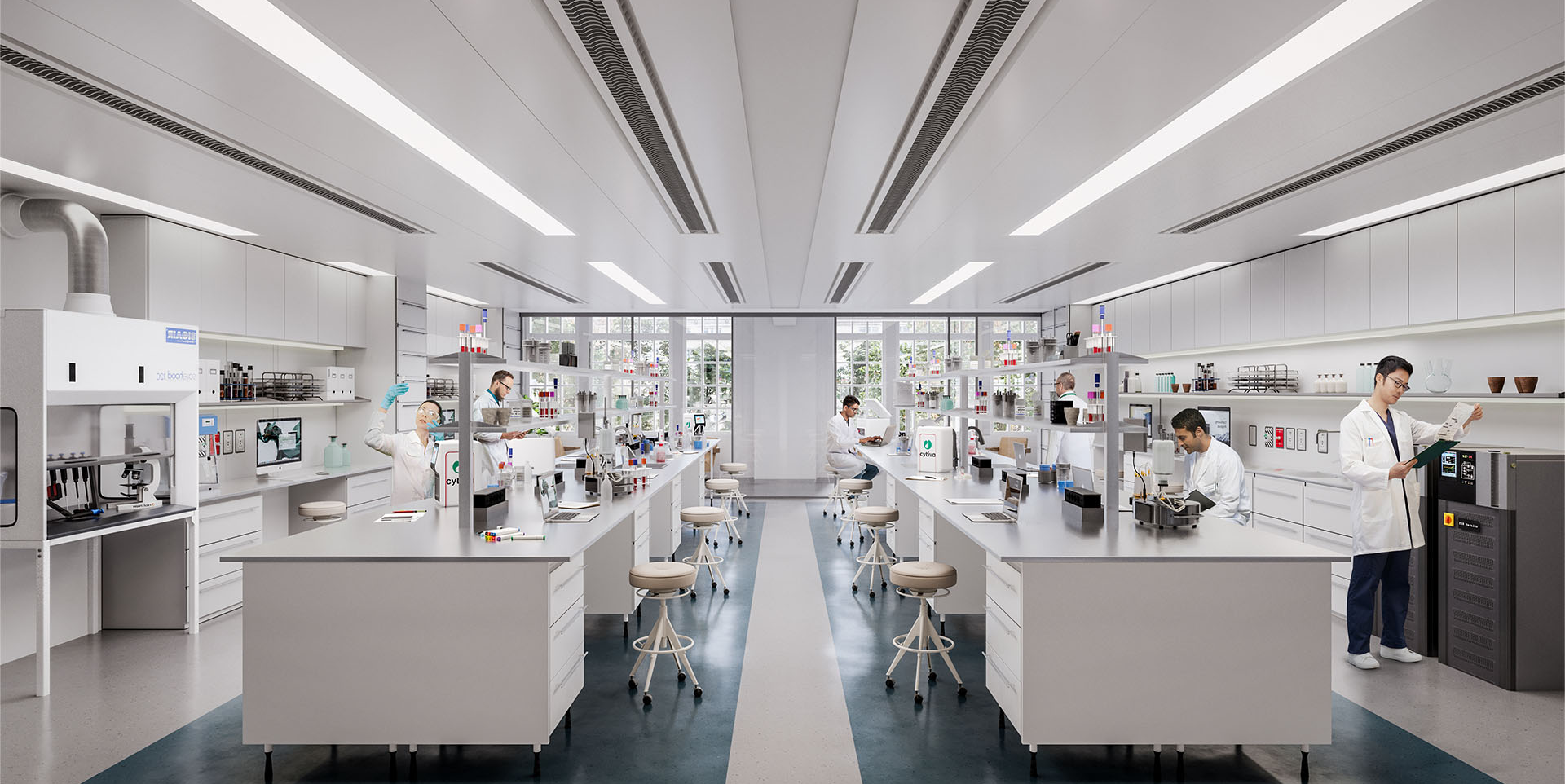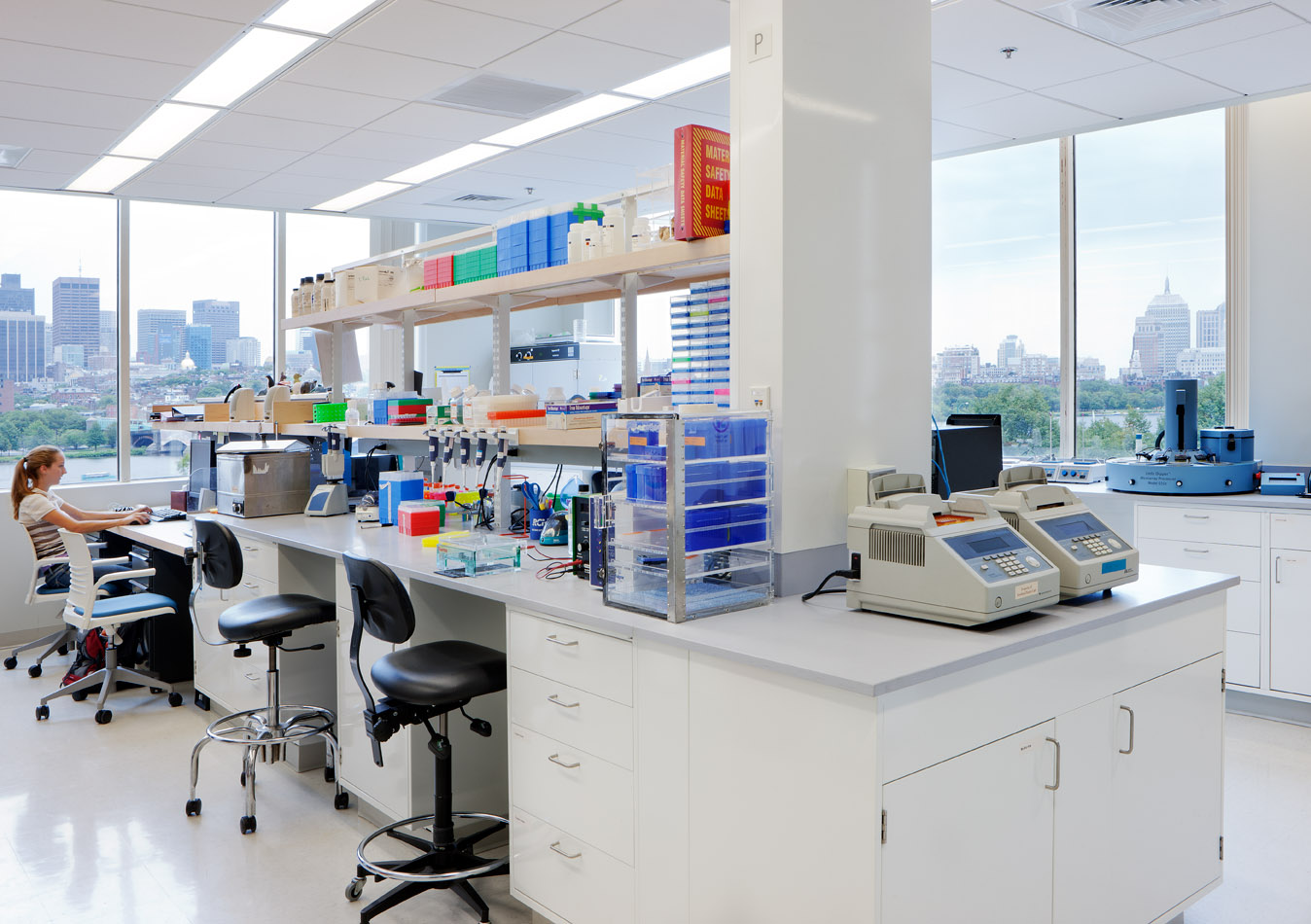The demand for science buildings is steadily growing. As advancements in medicine and private investments in research surge, the need for more, better-designed laboratories and support spaces increases.
And the growth isn’t just taking place in traditional science and medical clusters like San Diego, San Francisco and Boston — it’s also permeating emerging areas such as Los Angeles and Denver.
Here are five trends we discovered from recent research and how they are being actively translated them into our projects to help shape a more sustainable and efficient future.
1 – Modern Innovation Hubs
Just as new geographic life science clusters are popping up nationwide, smaller clusters of diverse, concentrated facilities are, too. Called innovation hubs, these developments are essentially campuses that support research companies in their endeavor to create and develop new ideas. Generally, they include wet and dry laboratory spaces and access to centralized equipment as well as conference and collaboration spaces.
Innovation hubs are becoming more prevalent as people realize how important and influential shared data and findings can be. They are often located near healthcare facilities for combined research opportunities, universities for attracting talent, and other amenities that are desirable for the workforce. Innovation hubs are beneficial to companies and institutions of all sizes and experience — from start-ups to established research groups — because they support learning from others and working together.
Due to the collaborative nature of their building programs, innovation hubs benefit from thoughtful design, as designers similarly leverage talent and opportunities to create solutions in their daily work. Planning and design for innovation hubs is crucial at the early development phase because they depend on proximity to other labs and research institutions. When designed and developed with the spirit of creative iteration and sharing they are intended for, innovation hubs can support a wide variety of high-impact scientific discoveries.
In recent years, life science and technology research entities have been locating or re-locating to populated urban areas. New technologies help make high-rise lab buildings more economically and socially feasible and the
2 – Flexible, Adaptable Labs
Scientists’ space requirements are transforming along with the real estate landscape, making flexible and adaptable laboratories more critical than ever before. Research needs for start-up companies often look quite different year-to-year and technological improvements in all parts of the life science sector are constantly changing workflows.
The ratio of lab space to office space is subject to change over time and a one-size-fits-all approach doesn’t support shifts and growth in personnel or projects. Flexibility in design allows for spatial enhancements that adapt to future changes.
While there are reasons to enclose some laboratory spaces such as biocontainment, noise mitigation, and environmental control, open laboratory concepts are increasingly desirable. Designs with open concepts promote interaction and resource sharing. When organized with a modular approach, labs and offices can become interchangeable and offer opportunities to flex spaces for increased efficiency with minimal disruption.
Other design solutions including movable furniture components and ceiling-mounted service panels for plug-and-play connections to workstations make modifications much easier. Sustainable rubber flooring products can be changed out much more easily than traditional epoxy flooring, which also allows for the laboratory to flex with the needs of scientists. As individual lab and office footprints become smaller and people seek more variation in their work settings, self-contained workstations that can easily move around are also becoming popular.

3 – Renovations on the Rise
Renovations are becoming increasingly popular in the life science and technology community. A lack of vacant greenspace in desirable areas for lab development has led to more projects that re-use outdated structures. Renovations are often both a sustainable solution and a financially smart choice. With the help of architects and planners, savvy real estate investors can quickly determine which vacant spaces make the most financial sense to become conversions.
Some existing buildings are easier and more cost effective to convert than others. Factors to consider include whether they have the proper structural floor-to-floor heights to accommodate the ductwork required for chemical fume hoods and instrumentation or appropriate column spacing to accommodate lab modules. Additional considerations designers think about when determining if a site makes sense to convert include available space for emergency back-up generators, service and delivery accommodations for loading docks, and bulk storage for specific gasses.
Though the most common type of renovation property for life science and technology conversation is an office building, warehouses and shopping malls have also become desirable. As more people shop online, malls have become less desirable for consumers to travel to, meaning there are many opportunities to leverage those structures that already have built-in conveniences such as parking and eateries to accommodate changing needs for researchers and scientists.
4 – More Amenities
Laboratories are places of discovery and amenity spaces can be as crucial to a facility’s ability to promote discovery as the labs themselves. By programming desirable amenity spaces, designers can help optimize the experience of those working in life science buildings. Gold standard amenities are crucial to attracting and retaining top talent for the highly competitive life science industry.
Scientists and researchers want buildings that support health. Amenities that focus on wellness and sustainability are increasingly key for life science buildings and campuses. Amenity spaces throughout buildings such as fitness rooms, showers, bike storage, and grab-and-go shops or cafés with nutritious food make workplaces more appealing and support holistic well-being. And supportive recreational and leisure spaces such as a yoga studio, meditation room, sport courts and game rooms allow for much needed exercise or downtime.

How Evolve can help you
We support scientific discovery by designing scientific environments that spark creativity, inspire innovation, and foster collaboration.
Our Malta-based design team balances the need for rigorous laboratory infrastructure and focus areas, with respite spaces where scientists can retreat, re-charge, and engage with others.
Successful Spec Labs Benefit Everyone
No matter what research and development endeavors are carried out in a converted lab, it’s important to understand that properly investing in site evaluation, its structures and potential future needs will lead to the most positive outcomes.
When developers build relationships with designers and engage them early in their building and site selection process, they have a stronger chance at long-term success for their properties.
Emphasis on Collaboration and Interaction
The modern laboratory is all about collaboration: between scientists of various disciplines, scientists doing wet bench work and computational work, and scientists and their colleagues in other departments of a company. To account for this shift in how science is conducted, architects are now adapting the open floor plan, a staple of the modern workplace, to work in laboratory settings. They’re also including more multipurpose and interstitial spaces in research environments to encourage impromptu and informal interactions. Amenities within research buildings are being expanded to provide a comfortable environment in which to work and to provide informal space for collaboration to occur.
Flexibility and Modularity
Because labs are expected to accommodate a variety of scientific research, our lab planners rely on modular design techniques to maximize the efficiency of the space. Reconfigurable casework, workstations on casters, and moveable partitions can accommodate a sudden need for a discrete, purpose-driven space within a larger lab and with minimal disruption to others. Flexibility is built into equipment zones that allows the lab to be reconfigured to accommodate new equipment. Our lab planners and engineers create a plug-and-play environment that is easily reconfigurable to accommodate new research equipment.
You might also be interested in
Be the first to hear our latest news, ideas and initiatives from Evolve
Laboratory equipment and much more
Whatever your next step, we’ll be by your side.
Evolve is Malta’s most trusted science parter, offering lab design, scientific consultancy services, environmental monitoring and the latest medical equipment from internationally trusted brands.
We have a comprehensive range of scientific equipment and medical supplies, shaped to suit the needs of hospitals, clinics, heritage sites, school labs, universities, medical cannabis facilities and leading pharmaceutical companies.
To find out about how Evolve can help you take your next step, get in touch with us today.


